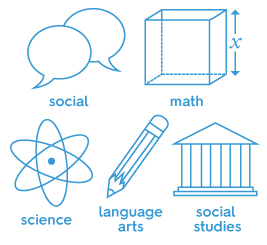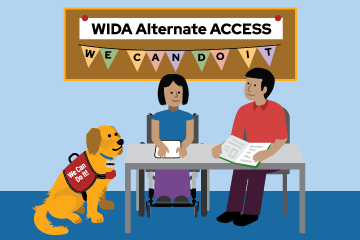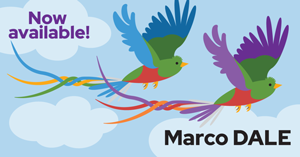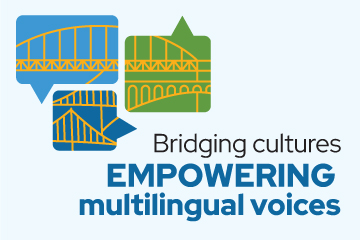Resources/Recursos
Featured Resources



All resources/Todos los recursos
Sample Alternate ACCESS for ELLs District Frequency Report
District Frequency Reports show the number and percentage of tested students who scored at each proficiency level. There are separate reports for each grade.
Resource Details View Download NowSample Alternate ACCESS for ELLs Individual Score Report
This report provides information about the student’s scores on the Alternate ACCESS for ELLs English language proficiency test. This test is based on the WIDA Alternate English Language Development Standards and is used to measure students’ progress in learning English. Scores are reported as Language Proficiency Levels and as Scale Scores.
Resource Details View Download NowSample Alternate ACCESS for ELLs School Frequency Report
School frequency reports show the number of students who've tested at each proficiency level for all domains. There are separate reports for each grade.
Resource Details View Download NowSample Alternate ACCESS for ELLs State Frequency Report
State Frequency Reports show the number and percentage of tested students who scored at each proficiency level. There are separate reports for each grade.
Resource Details View Download NowSample Alternate ACCESS for ELLs Student Roster Report
Student Roster Reports show individual students' domain, composite and overall scores. There are separate reports for each grade.
Resource Details View Download NowSample Can Do Student Portrait
A WIDA Can Do Student Portrait is a document that focuses on a student’s strengths with specific information about the learner’s educational background, languages, family and interests, in addition to what the student can do in English with information from the WIDA Can Do Descriptors and Proficiency Level Descriptors. This sample WIDA Can Do Student Portrait provides an example of one of the ways teachers may create student portraits.
Resource Details View Download NowScaffolding Learning for Multilingual Students in Math
This WIDA Focus Bulletin provides examples of specific macro-scaffolding and micro-scaffolding practices in action in a math classroom and includes guidance for developing these scaffolding practices over time.
Published June 2018
Authors: Jen Daniels, Ruslana Westerlund
Siguiendo la conversación: El rol de la interacción en el desarrollo del lenguaje
La interacción es de gran importancia en los salones de clases, donde los estudiantes bi/multilingües intercambian ideas y contribuyen a una comunidad educativa a medida que continúan ampliando su repertorio lingüístico. Esto explica por qué la interacción es una de las seis ideas principales del Marco DALE. En este boletín de enfoque, exploramos la interacción y su conexión con las multiliteracidades y los modos de comunicación y expectativas del lenguaje del Marco DALE.
Publicado 2024
Autores: Analleli Hernández, Margo Gottlieb
Standards Framework and its Theoretical Foundations
This document articulates the theoretical foundations for the 2012 Amplification of the WIDA English Language Development Standards, Kindergarten-Grade 12. The 2012 Amplification and its theoretical foundations are in the process of being retired. For the most up-to-date information, please see Appendix F: Theoretical Foundations in the WIDA ELD Standards Framework, 2020 Edition.
The 2012 Amplification of the WIDA ELD Standards drew on multiple theories and approaches in an effort to describe language use in academic contexts, as this is the language students must acquire and negotiate to participate successfully in school. These multiple theories and approaches formed a theoretical foundation that supported the 2012 WIDA ELD standards framework. This document articulates that theoretical foundation.
Resource Details View Download NowSTEM Discourse
This WIDA Focus Bulletin explores ways to strengthen reasoning and language in Science, Technology, Engineering, and Mathematics (STEM) education.
Published January 2017
Author: Rita MacDonald
Students with Limited or Interrupted Formal Education (SLIFE)
This WIDA Focus Bulletin focuses on the needs of students who have limited or interrupted formal education. Because the vast majority of students in this group are enrolled in grades 6 through 12, we will focus on those grade levels. However, many of the tips and suggestions can be applied in lower grade levels as well. Throughout the bulletin we will explore academic and social-emotional factors that may affect this group of students, examine the benefits of building community partnerships, address how to assess student readiness levels, and offer a checklist of considerations for instructional planning.
Published May 2015
Authors: Lauren Keppler, Lucia Morales, Julia Cortada, Maria Austin
Supporting Multilingual Learners Language Growth Through Language Development Portfolios
This Focus Bulletin illustrates how teachers and students can use language development portfolios to interpret and document language growth. The bulletin follows the story of how a grade-level team introduced portfolios to their practice, posing several questions the team asked as they refined their usage. It closes by offering two sample tools that teachers can use and adapt to capture multilingual learners’ language growth using modified Proficiency Level Descriptors (PLDs) from the WIDA English Language Development Framework, 2020 Edition.
Published: December 2022
Authors: Fernanda Marinho Kray, Margo Gottlieb, Lynn Shafer Willner
Supporting Multilingual Students with WIDA and International Baccalaureate Resources
This Focus Bulletin illustrates how educators in featured International Baccalaureate schools are integrating WIDA resources as they design lessons for multilingual learners.
Published June 2019
Authors: Jon Nordmeyer, Ruslana Westerlund, Elizabeth Cranley, Anne Katz
Teaching for Equity: The CLEAR Paradigm
This working paper provides insights into how all teachers can provide linguistically and culturally responsive and equitable education for all students by orchestrating instruction to meet their varying socioemotional, cultural, linguistic and academic needs. Grounded in social justice, the Cultural, Linguistic, Equity, and Responsiveness (CLEAR) paradigm presented in this paper describes a guiding framework for educators who wish to integrate sociocultural and sociolinguistic responsiveness and critical pedagogical practices to achieve quality, equitable education for their students.
Resource DetailsTechnology in the Classroom
This WIDA Focus Bulletin addresses how English Language Learners engage with technology within the classroom.
Published October 2014
Authors: Meagan Rothschild, Julia Cortada
The Value of Interim English Language Proficiency Assessment Data
In this recorded webinar, Mark Chapman, senior assessment innovation manager at WIDA, discusses the value of interim English language proficiency data and how WIDA's interim assessment, WIDA MODEL, can be used to support instruction for multilingual learners.
Resource DetailsThe WIDA Framework for Equitable Instruction of Multilingual Children and Youth in Content-Area Classrooms
The Framework for Equitable Instruction (FEI) is an instruction-focused resource designed to promote the equitable engagement in disciplinary learning and language development of multilingual learners. The FEI complements the WIDA ELD Standards Framework, 2020 Edition. This working paper can inform teachers’ practice, support teacher collaboration within and across disciplines, and serve as a foundation for the design of professional learning opportunities and resources.
Resource DetailsTitle III National Evaluation Supplemental Report
This report addresses three primary questions:
1. How do you determine a meaningful English language performance standard?
2. How do you establish a realistic, empirically anchored time frame for attaining a given ELP performance standard?
3. How can states take into account English learners’ English language performance level when setting academic progress and proficiency expectations?
Published May 2013
Resource Details View Download NowTool to Evaluate Language Complexity of Test Items
This paper focuses on the creation of an instructional hyper textbook that serves as a personal environment for learning a less-commonly-taught language, Turkish in this case. It shows how digital personal environments can advance self-regulated language learning in tandem with more formal learning strategies.
Resource DetailsTranslanguaging
This focus bulletin explores translanguaging from the perspective of four educators, spanning kindergarten through high school. Translanguaging, a common practice among multilingual people, can be explained as using all languages and language varieties available to communicate and understand the world around oneself. The bulletin provides specific ideas on how to use translanguaging to create spaces for students' multilingualism and includes reflection questions to help educators adopt translanguaging strategies in their practice.
Resource Details View Download Now




